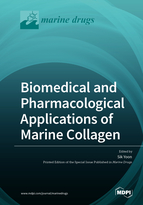Biomedical and Pharmacological Applications of Marine Collagen
A special issue of Marine Drugs (ISSN 1660-3397).
Deadline for manuscript submissions: closed (30 November 2022) | Viewed by 25214
Special Issue Editor
Interests: biomaterials; 3D cell culture; organoids; marine biology; cancer; immunology; cell biology; thymus regeneration
Special Issues, Collections and Topics in MDPI journals
Special Issue Information
Dear Colleagues,
Marine Drugs invites submissions to this Special Issue on “Biomedical and Pharmacological Applications of Marine Collagen”.
Biomimetic polymers and materials have been widely used in a variety of biomedical and pharmacological applications. Particularly, collagen-based biomaterials have been extensively applied in various biomedical fields, such as scaffolds in tissue engineering. However, there are many challenges associated with the use of mammalian collagen, including the issues of religious constrains, allergic or autoimmune reactions, and the spread of animal diseases such as bovine spongiform encephalopathy, transmissible spongiform encephalopathy, and foot-and-mouth disease. Over the past few decades, marine collagen (MC) has emerged as a promising biomaterial for biomedical and pharmacological applications. Marine organisms are a rich source of structurally novel and biologically active compounds, and to date, many biological components have been isolated from various marine resources. MC offers advantages over mammalian collagen due to its water solubility, easy extractability, low immunogenicity, safety, biocompatibility, biodegradability, antimicrobial activity, functionality, and low production costs. Due to its characteristics and physicobiochemical properties, it has tremendous potential for use as a scaffold biomaterial in tissue engineering and regenerative medicine, in drug delivery systems, and as a therapeutic.
In this Special Issue, we encourage submissions related to the recent developments, advancements, trends, challenges, and future perspectives in this new research field. We expect to receive contributions from different areas of multidisciplinary research, including—but not restricted to—extraction, purification, characterization, fabrication, and experimentation of MC, with a particular focus on their biotechnological, biomedical and pharmacological uses. Comprehensive review papers are also welcome in this Special Issue.
Dr. Sik Yoon
Guest Editor
Manuscript Submission Information
Manuscripts should be submitted online at www.mdpi.com by registering and logging in to this website. Once you are registered, click here to go to the submission form. Manuscripts can be submitted until the deadline. All submissions that pass pre-check are peer-reviewed. Accepted papers will be published continuously in the journal (as soon as accepted) and will be listed together on the special issue website. Research articles, review articles as well as short communications are invited. For planned papers, a title and short abstract (about 100 words) can be sent to the Editorial Office for announcement on this website.
Submitted manuscripts should not have been published previously, nor be under consideration for publication elsewhere (except conference proceedings papers). All manuscripts are thoroughly refereed through a single-blind peer-review process. A guide for authors and other relevant information for submission of manuscripts is available on the Instructions for Authors page. Marine Drugs is an international peer-reviewed open access monthly journal published by MDPI.
Please visit the Instructions for Authors page before submitting a manuscript. The Article Processing Charge (APC) for publication in this open access journal is 2900 CHF (Swiss Francs). Submitted papers should be well formatted and use good English. Authors may use MDPI's English editing service prior to publication or during author revisions.
Keywords
- Marine collagen
- Extraction, purification, characterization, synthesis and fabrication
- Biological activity
- 3D cell culture, bioprinting and organoids
- Tissue engineering and regenerative medicine
- Nanomedicine and drug delivery
- Therapy and theranostics
- Biomedical, pharmacological, nutraceutical and biotechnological applications







